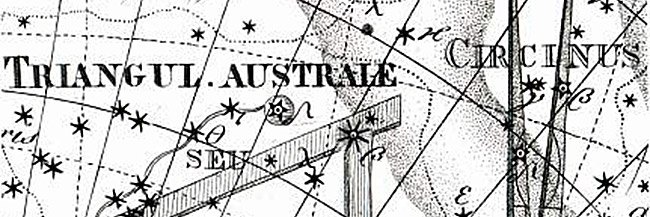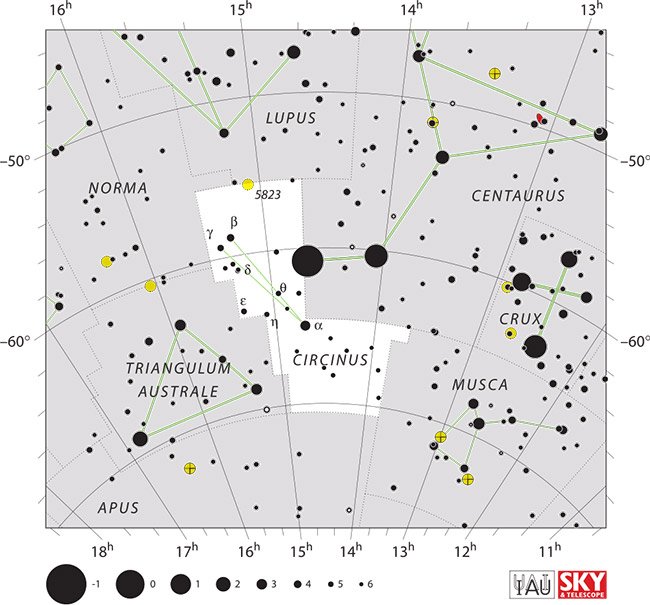Circinus – Constellation Facts

Circinus is another relatively small constellation, in fact it comes in at the fourth smallest constellation in the night sky. It is located in the third quadrant of the Southern hemisphere and can be viewed specifically at latitudes between +30° and -90°. Its name is derived from the Latin language “the compass”; the tool used for drawing circles.
Constellation Characteristics
Circinus is 85th in overall size, covering an area of 93 square degrees. It is neighbors with the constellations of Apus, Centaurus, Lupus, Musca, Norma and Triangulum Australe. In addition, Circinus has no Messiers or meteor showers.

IAU and Sky & Telescope magazine (Roger Sinnott & Rick Fienberg), CC BY 3.0, via Wikimedia Commons
By IAU and Sky & Telescope magazine (Roger Sinnott & Rick Fienberg) CC BY 3.0, via Wikimedia CommonsPlanetary Systems
Circinus has three deep sky objects. Read on to discover some fascinating facts about these celestial wonders.
- Circinus Galaxy: located 13 million light-years away, this spiral galaxy has two rings inside of it produced by gas. One of the rings is notable for its star forming abilities. In addition, this galaxy has a black hole powered core.
- Circinus X-1: known for being an X-ray double star, this deep space object is made up of a neutron star and a sequence star in which the neutron orbits the sequence star.
- NGC 5315: this planetary nebula was created (as all planetary nebulae are) by a star casting off its outer layers in the final stages of its life.
Main Stars
The constellation Circinus consists of only four main stars that makes up its shape. Let’s explore them further.
- Alpha Circini is the brightest star in the Circinus constellation (which will be discussed later in detail).
- Beta Circini comes in at the second brightest star in Circinus and is made up of a main sequence star. It is located about 97 light-years from Earth.
- Gamma Circini is a binary star made up of two blue and yellow stars.
- HD 129445 is a star with a planet in its orbit (HD 129445 b). It is located 220 light-years away.

Circinus from Chart XX of the Uranographia of Johann Bode
Circinus from Chart XX of the Uranographia of Johann BodeMost Shining Star
Out of all the stars that make up the Circinus constellation, none shine brighter than Alpha Circini. It is situated an estimated 53.5 light-years away and is made up of two components. It is a visual binary with a dimmer companion and classified as a rapidly oscillating Ap star.
Mythology & History
Although the Circinus constellation has no mythology surrounding it, it does have a story. This constellation came to be by a French astronomer by the name of Nicolas Louis de Lacaille. He created “Le Compass” to fill the void in the sky between Triangulum Australe (depicted as a surveyor’s level) and other constellations.
Circinus is a fascinating constellation, so the next time you are gazing into the night sky be sure to search out this intriguing figuration of stars.
